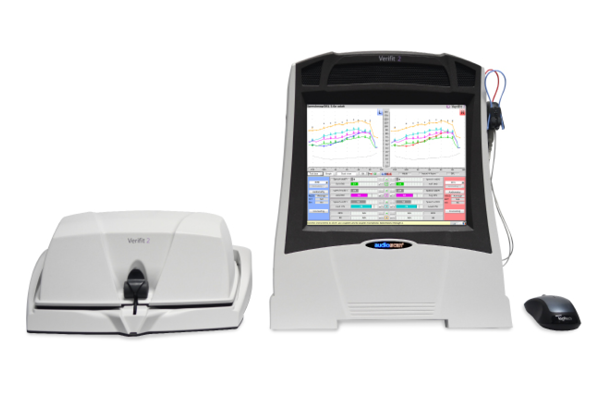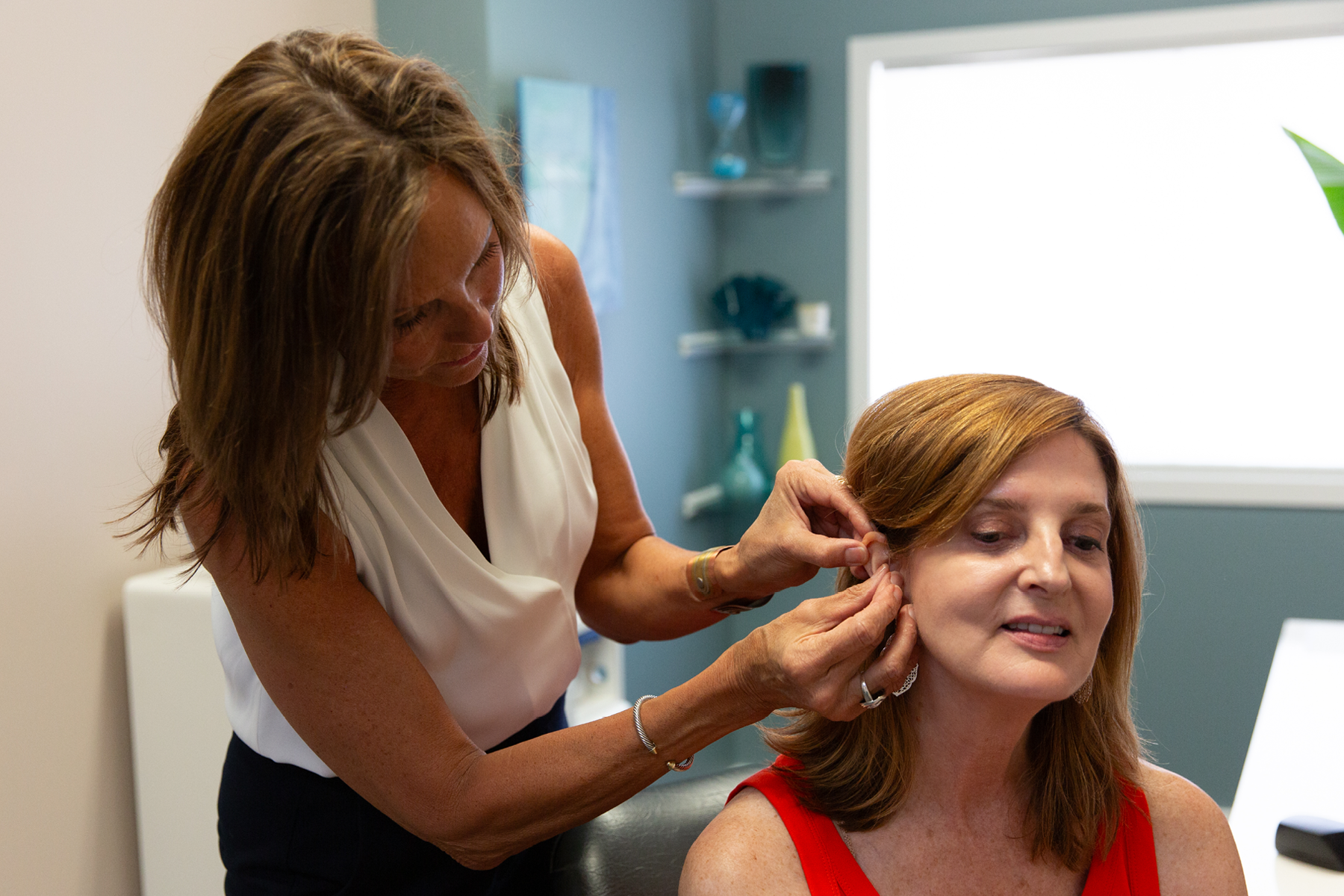This article was written by Kristin Johnston, B.A., BC-HIS, a HearingLoss.com®-Certified Provider located at Comprehensive Ear & Hearing in Grand Haven, MI.
Getting professionally fitted with hearing aids is a critical investment in your health, your communication, and your connection with the world. When taking that important step, you want your hearing aids to work their best.
But how do you know your new devices are working like they should? Are they programmed correctly for your hearing levels and listening needs? Could a simple tweak help them provide an even more empowering experience?
Real-ear measurement plays a big role in answering those key questions. It’s an indispensable part of the better-hearing process that every clinic should provide — but not everyone does. Read on for more on what real-ear measurement is, why it’s essential, and how you can get the benefits right now.
What Is Real-Ear Measurement?

Real-ear measurement, or REM, tests how well a hearing device is performing in your ear. It gauges the device’s sound output based on your individual ear shape, acoustics, and the hearing instrument’s settings. This helps your hearing care provider determine how much sound your hearing aid is producing in real time, ensuring your optimum benefit for hearing conversations and other meaningful situations.
As a verification tool, REM helps determine whether your devices meet prescribed amplification targets. It measures the exact sound output at the eardrum, accounting for differences in ear canal size and shape that can affect how sound is perceived. By recording these in-ear sound levels, REM provides a detailed, graphic view of how the hearing aid performs in that specific environment. You’ll not only hear the difference but also see the difference.
How Does Real-Ear Measurement Work?
Real-ear measurement is fast, effective, and painless. In just minutes, it provides valuable insights into how your devices amplify sound in your ears. Here’s what to expect during a REM test:
- A tiny microphone is placed in your ear canal alongside your hearing aid to measure how sound is amplified inside the ear.
- Various speech and sound signals are played to assess how well your hearing aid is delivering the right amplification for different frequencies.
- These measurements are compared to your hearing test results, allowing your provider to fine-tune your hearing aids for maximum clarity and comfort.
- Your hearing care provider may have you listen and provide feedback, making final adjustments that take into account your real-world listening preferences and needs.
REM helps ensure your devices provide the right amplification at the right pitches, improving speech understanding and overall hearing satisfaction. With real-time adjustments based on precise measurements, your provider can optimize your hearing aids on the spot.
Why Is Real-Ear Measurement Essential?

Hearing aids aren’t a one-size-fits-all solution. Your ear shape, ear canal size, and degree of hearing loss all affect how sound reaches your inner ear. Without real-ear measurement, your hearing aid settings are potentially based on average estimates rather than your actual hearing needs.
Real-ear measurement helps:
- Ensure a personalized fit, tailoring your hearing aid settings to the unique shape and acoustics of your ears rather than relying on generic programming.
- Enhance speech clarity, verifying amplification at different frequencies so you can follow conversations even in noisy environments.
- Prevent under- or overamplification, so the sound from your hearing aid devices isn’t too soft or too loud.
- Support long-term hearing health, with proper calibration to help preserve your hearing by ensuring safe, effective amplification over time.

Missing Life’s Moments? Your Hearing Aids Might Not Be Calibrated Right
Even the best hearing aids can fall short if they aren’t calibrated using real-ear measurement. It’s the key to hearing clearly and staying connected to what matters most.
Is Real Ear-Measurement Accurate?
Yes. Real-ear measurement, a best practice in audiologic care as outlined by the American Academy of Audiology, is one of the most accurate methods for verifying hearing aid performance. It provides objective, real-time data on the exact sound levels reaching the eardrum, accounting for the unique shape and acoustics of your individual ear canal.
Personal opinions on sound quality can vary. REM provides objective data on what your hearing aids are actually delivering. It offers a clear and precise reading of amplification levels, making it a standardized way to evaluate hearing aid function. This helps ensure a more complete picture of your device’s performance, making it easier to fine-tune for better performance.
Because REM directly measures the output of the hearing aid inside the ear rather than relying on estimates or manufacturer presets, it offers a precise assessment. This level of accuracy ensures that the hearing aid is meeting prescribed targets based on your specific hearing test results and communication needs.
Real-Ear Measurement vs. Speech Mapping: Are They the Same?
Speech mapping is a form of real-ear measurement that uses recorded or live speech signals to show how speech sounds are amplified in the ear. While traditional REM verifies the hearing aid’s overall amplification against desired targets, speech mapping helps visualize how the device processes speech sounds, offering a helpful tool for fine-tuning settings.
Not all REM procedures involve speech mapping. While speech mapping can be beneficial for assessing speech clarity, traditional REM still provides essential verification of the hearing aid’s performance and helps ensure accurate amplification across different frequencies. Both approaches are valuable for ensuring hearing aids work effectively for your needs.
Do All Hearing Care Providers Use Real-Ear Measurement?
Unfortunately, this crucial best practice isn’t part of every clinic’s fitting process. In fact, only 30% of hearing care providers regularly perform real-ear measurements. When choosing a provider, ask if they perform real-ear measurements to help ensure you get the best possible results from your hearing aids. Working with a HearingLoss.com-Certified clinic provides peace of mind that your hearing health care team follows clinical and patient best practices, including real-ear measurement.

Find an Expert Who Uses Real-Ear Measurement
Make sure your hearing aids are fit with precision. Real-ear measurement is a gold-standard test but not every provider uses it. Connect with a HearingLoss.com-Certified Provider near you to get expert care that includes REM, personalized fittings, and better long-term hearing results.
How Can I Take Advantage of Real-Ear Measurement?

If you already wear hearing aids or are considering them, make sure your provider includes real-ear measurement as part of your fitting. This can make a world of difference, helping ensure your devices deliver the right level of sound for speech clarity and overall listening comfort.
Keep in mind also that hearing can change over time. If you’ve had REM performed in the past but are now struggling to hear in certain situations, consider a follow-up appointment to fine-tune your settings, and be sure to schedule regular hearing checkups.
How Can HearingLoss.com Support Your Hearing Journey?
Hearing aids should do more than just make things louder. They should help you reconnect, communicate, and live fully. As a provider dedicated to delivering the highest level of care, my colleague, Cadan Kleinheksel, and I use real-ear measurement to make sure your hearing aids are fine-tuned to your unique needs. It’s one of the most effective ways to ensure your devices are working their best for you.
That’s why we are proud to be part of the HearingLoss.com network. Every HearingLoss.com-Certified provider follows clinical and patient best practices, including using real-ear measurement during hearing aid fittings and follow-ups. Our adherence to these crucial practices reflects a shared commitment to patients’ well-being and long-term hearing success.
If you or someone you care about is looking for a hearing care provider who puts patient outcomes first, we encourage you to explore the tools and resources available at HearingLoss.com. From expert-written articles to a robust provider directory, it’s a great place to start your journey or take the next step.
Comprehensive Ear & Hearing in Grand Haven is dedicated to helping Michiganders hear their best and enhance their quality of life. With expert diagnostics, personalized treatment, and advanced hearing technology, the practice goes beyond simply providing hearing aids — it delivers compassionate, patient-first care. The knowledgeable team supports every step of the hearing journey, from thorough testing to customized solutions and dedicated follow-up. With a commitment to expertise and a personal touch, Comprehensive Ear & Hearing ensures patients receive the highest standard of care.
References
- ONLINE FEATURE | Real-Ear Verification for the New Professional. (n.d.). American Academy of Audiology website: https://www.audiology.org/news-and-publications/audiology-today/articles/online-feature-real-ear-verification-for-the-new-professional/


